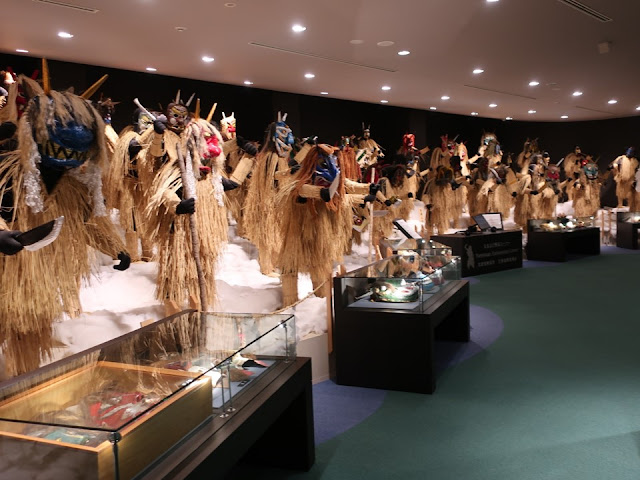In Oga peninsula which is at the northern
part of Japan, “Namahage” visit families only once a year; it is New Year’s
Eve. They seek for lazy people especially children and punish them. At the same
time, they pray for the family’s happiness, a rich harvest and a good catch. I
think it is a treasure of Oga.
This museum shows us all about Namahage.
なまはげは、年に一度だけ、大晦日の夜に家にやってきます。怠け者を探し出して懲らしめ、そして家族の無病息災と豊作豊漁を約束して山に帰ります。秋田の宝だと思います。
ここ博物館では、男鹿半島となまはげの全てを紹介しています。
First of all, the lives in Oga are exhibited including old ones.
男鹿半島の海の暮らしの展示から。
Oga in the Edo period (1603~1868): People in Oga have received a blessings from the sea. Mountains in Oga are landmarks of fishermen, and those are places where gods reside too.
江戸時代の男鹿半島。右はなまはげが持っている刃です。男鹿の人々は海の恵みを受け、男鹿の山々は船乗りの目印であり、地元の人々にとっては神が宿る場所でした。
Going to the next building which has a theater.
シアターがある次の建物へ。
You can take photo with Namahage here.
なまはげに変身して写真撮影できます。
There are models and panels in the theater.
スクリーンの周りにはたくさんの展示品があります。
The family head welcomes Namahage which are deities that bring rich haul and harvest.
なまはげを迎える主人。なまはげは、怠け者を戒めるだけでなく、豊作や大漁を約束してくれる神です。
Namahage seek for lazy people. Children fear and cry.
怠けていないか、と迫るなまはげに、こどもは泣きじゃくります。
Namahage gather at the shrine, drink sake(alcohol) and visit houses. Then, they return to the shrine and leave their coats. It is the end of the event. Next morning, which is the New Year’s Day, children find the Namahage’s coats.
なまはげは神社に勢揃いし、酒を頂いて、家々を廻ります。その後、ケデ(簑)を狛犬やご神木に巻いて行事を終えます。元旦に、子ども達はケデを見るわけです。
Snow covers ground when Namahage appear.
なまはげには、雪が似合いますね。
This is Sedo festival which is held in Shinzan Shrine, which is next to the museum, for a thousand years. It is thought that Namahage are similar to demons which grab baked mochi cakes and return to the mountain. Mochi is thought to be a substitution of a human sacrifice.
平安時代から行われていたと言われる真山神社の柴灯(せど)祭。「あぶった餅を掴んで山へ去って行く鬼神となまはげが重ねられるようになった」と書かれています。餅は、人身御供の代わりとも言われています。
Mountain worship in Oga、男鹿の山岳信仰
There are holy sites in Honzan and Shinzan where most of Namahage are. Men in Oga used to pilgrim mountains on the 15th of June in lunar calendar. They walked 11km among the mountains, after that, they were recognized as an adult. The photo above is the departure of the pilgrimage around a hundred years ago.
なまはげのほとんどが住んでいるといわれる本山、真山は天台宗の霊場でした。男鹿に生まれた者は、一度は、旧暦6月15日のお山かけ(11kmを神々を拝みながら行く)をする習慣がありました。お山かけをして初めて一人前と言われます。上の写真はお山かけに出かける人々(大正時代)です。
Legends of Namahage、なまはげ伝説
Four typical stories about the origin are explained; mountain gods, mountain monks, foreigners who drifted down to Oga and Chinese demons.
なまはげの諸相がパネルで展示されています。勉強になります。なまはげの起こりについて、代表的な四つの説が説明されています。①山の神説、②修験者説、③異邦人説(男鹿に漂着した外国人)、④武帝五鬼説(漢の武帝が五匹の鬼を従えて男鹿に来て、村人が鬼をなだめるために行った行事)です。
Ritual visits of deities in masks and costumes like Namahage are held across Japan. Most of them are carried out in New Year’s or Bon. Ten rituals including Namahage were designated as UNESCO world intangible cultural heritage in 2018.
なまはげのような、来訪神の行事は日本各地にあります。正月か盆の行事ですね。なまはげを含む10件がユネスコ無形文化遺産に2018年に登録が決定されました。
Masks of visiting deities in the world are also exhibited.
世界各地の来訪神のお面も紹介されています。
Namahage room、なまはげ展示室
One hundred ten bodies are displayed. The photo above is the left side.
110体が展示されています。これは左側。
This is the left side, so dynamic! The design varies by the village. Some of them have a knife or an ax.
こちらが右側。大迫力ですね。集落によって随分と異なります。
I ate uni (sea urchin) rice bowl at Mikasa Kaikan in Nyudouzaki. Uni is delicious and the sauce is good.
入道崎、ミカサ会館のウニ丼。ウニも美味いが、タレも美味かったです。
Oga is actually a difficult place to live, however Namahage give a superior pastime!
男鹿は、厳しい土地だと思います。でも、その中で、なまはげは、楽しいひとときを人々に与えてくれています。
Visited in October, 2020
Official website: https://namahage.co.jp/namahagekan/en/oga_shinzan_folklore_museum/
https://namahage.co.jp/namahagekan/oga_shinzan_folklore_museum/ (in Japanese), accessed in Jun, 2021
Previous post (Namahage performance at the same site/Must check):
Oga Shinzan Folklore Museum、男鹿真山伝承館
Next post (The
largest museum in Akita):
Akita Prefectural Museum (1/2)、秋田県立博物館 (1/2)






















Comments
Post a Comment